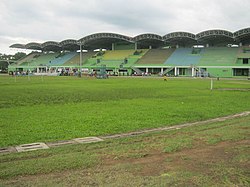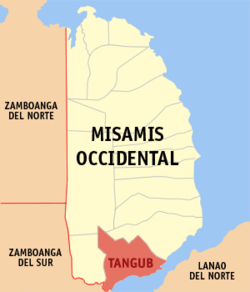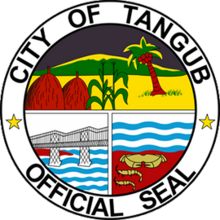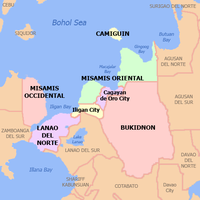Tangub
Tangub | |
|---|---|
| City of Tangub | |
 Tangub City Sports Complex | |
| Nickname: Christmas Symbols Capital of the Philippines | |
 Map of Misamis Occidental with Tangub highlighted | |
Location within the Philippines | |
| Coordinates: 8°04′00″N 123°45′00″E / 8.06666667°N 123.75°E | |
| Country | Philippines |
| Region | Northern Mindanao |
| Province | Misamis Occidental |
| District | 2nd district |
| Founded | December 4, 1929 |
| Cityhood | June 17, 1967 |
| Barangays | 55 (see Barangays) |
| Government | |
| • Type | Sangguniang Panlungsod |
| • mayor of Tangub[*] | Sabiniano "Ben" S. Canama (NP) |
| • Vice Mayor | Tito B. Decina (PDPLBN) |
| • Representative | Sancho Fernando "Ando" F. Oaminal (NP) |
| • City Council | Members |
| • Electorate | 43,729 voters (2022) |
| Area | |
| • Total | 162.78 km2 (62.85 sq mi) |
| Elevation | 243 m (797 ft) |
| Highest elevation | 2,421 m (7,943 ft) |
| Lowest elevation | 0 m (0 ft) |
| Population (2020 census)[3] | |
| • Total | 68,389 |
| • Density | 420/km2 (1,100/sq mi) |
| • Households | 15,456 |
| Economy | |
| • Income class | 4th city income class |
| • Poverty incidence | 27.33 |
| • Revenue | ₱ 652 million (2020) |
| • Assets | ₱ 1,846 million (2020) |
| • Expenditure | ₱ 435.1 million (2020) |
| • Liabilities | ₱ 487.2 million (2020) |
| Service provider | |
| • Electricity | Misamis Occidental 2 Electric Cooperative (MOELCI 2) |
| Time zone | UTC+8 (PST) |
| ZIP code | 7214 |
| PSGC | |
| IDD : area code | +63 (0)88 |
| Native languages | Subanon Cebuano Tagalog |
| Feast date | September 29 |
| Catholic diocese | Archdiocese of Ozamis |
| Patron saint | Michael the Archangel |
| Website | tangubcity |
Tangub, officially the City of Tangub (Cebuano: Dakbayan sa Tangub; Filipino: Lungsod ng Tangub), is a 4th class component city in the province of Misamis Occidental, Philippines. According to the 2020 census, it has a population of 68,389 people.[3]
Tangub City is also where the Panguil Bay Bridge is situated. Once completed, the 3.77 km (2.34 mi) bridge will connect Tangub, Misamis Occidental to Tubod, Lanao del Norte.
History
[edit]The city of Tangub grew from a small town. The city's name came from the Subanen word "Tangkub", which is a rice container made of tree bark woven together by rattan strips. There are several stories regarding how Tangub got its name. One version tells about a Spanish soldier on patrol in the area who found a dead man whom the Subanens described as bitten by a snake inside the “tangkub” when he checked if there was still rice in the container. Not understanding the dialect, the soldiers reported that there was a dead man from “tangkub” and the name stuck, which later on was changed to Tangub. Another version is about Spanish soldiers who got lost and encountered a Subanen couple. When asked about the location, the couple, thinking they were asked about the containers they were carrying, replied with "tangkub".[5]
Trade and commerce emerged when many agricultural products were harvested, and the Subanens bartered their land for goods brought in by other Christian settlers from Luzon and Visayas. Years after, Chinese merchants settled in this place and helped to hasten the transportation of the settlements into a civilized communities. Tangub became successful during the years 1898–1910. With the growing community, a group of community leaders led a movement for the town to be an independent municipality, calling themselves the "Aspiracion Committee".
On December 4, 1929, Tangub became a municipality by virtue of an executive order by American Governor-General Dwight Davis, and was renamed Regidor, in honor of Dr. Antonio Maria Regidor, a lawyer and diplomat who supported the Secularization movement during the Spanish regime. In this process, Regidor was separated from its mother municipality of Misamis, now Ozamiz City. The new municipality of Regidor then included all the barrios of the present municipality of Bonifacio, formerly known as Digson. The name of the municipality was reverted to Tangub by virtue of Act No. 3701 on November 20, 1930.
Cityhood
[edit]On June 17, 1967, under Republic Act No. 5131, Tangub became a chartered city. .
Geography
[edit]Tangub is close to Zamboanga del Sur and Zamboanga del Norte provinces, while across the bay is Lanao del Norte. Tangub is 77.1 km (77,100 mi) from Maria Cristina Falls, the main source of hydroelectric power in Mindanao.
Barangays
[edit]Tangub is politically subdivided into 55 barangays. Each barangay consists of puroks while some have sitios.
- Silanga
- Marcos (Aquino)
- Santa Maria (Baga)
- Balatacan
- Baluk
- Banglay
- Mantic
- Mingcanaway
- Bintana
- Bocator
- Bongabong
- Caniangan
- Capalaran
- Catagan
- Barangay I - City Hall (Poblacion)
- Barangay II - Marilou Annex (Poblacion)
- Barangay IV - St. Michael (Poblacion)
- Isidro D. Tan (Dimalooc)
- Garang
- Guinabot
- Guinalaban
- Hoyohoy
- Kauswagan
- Kimat
- Labuyo
- Lorenzo Tan
- Barangay VI - Lower Polao (Poblacion)
- Lumban
- Maloro
- Barangay V - Malubog (Poblacion)
- Manga
- Maquilao
- Barangay III- Market Kalubian (Poblacion)
- Matugnao
- Minsubong
- Owayan
- Paiton
- Panalsalan
- Pangabuan
- Prenza
- Salimpuno
- San Antonio
- San Apolinario
- San Vicente
- Santa Cruz
- Santo Niño
- Sicot
- Silanga
- Silangit
- Simasay
- Sumirap
- Taguite
- Tituron
- Tugas
- Barangay VII - Upper Polao (Poblacion)
- Villaba
Climate
[edit]| Climate data for Tangub City, Misamis Occidental | |||||||||||||
|---|---|---|---|---|---|---|---|---|---|---|---|---|---|
| Month | Jan | Feb | Mar | Apr | May | Jun | Jul | Aug | Sep | Oct | Nov | Dec | Year |
| Mean daily maximum °C (°F) | 29 (84) |
30 (86) |
31 (88) |
31 (88) |
30 (86) |
30 (86) |
29 (84) |
30 (86) |
30 (86) |
30 (86) |
30 (86) |
30 (86) |
30 (86) |
| Mean daily minimum °C (°F) | 22 (72) |
22 (72) |
22 (72) |
23 (73) |
24 (75) |
24 (75) |
24 (75) |
24 (75) |
24 (75) |
24 (75) |
23 (73) |
23 (73) |
23 (74) |
| Average precipitation mm (inches) | 69 (2.7) |
58 (2.3) |
67 (2.6) |
60 (2.4) |
109 (4.3) |
114 (4.5) |
83 (3.3) |
78 (3.1) |
76 (3.0) |
92 (3.6) |
86 (3.4) |
63 (2.5) |
955 (37.7) |
| Average rainy days | 12.8 | 11.6 | 14.8 | 17.4 | 24.8 | 23.5 | 20.7 | 18.5 | 17.4 | 22.5 | 21.6 | 15.6 | 221.2 |
| Source: Meteoblue[6] | |||||||||||||
Demographics
[edit]| Year | Pop. | ±% p.a. |
|---|---|---|
| 1939 | 44,743 | — |
| 1948 | 20,353 | −8.38% |
| 1960 | 21,101 | +0.30% |
| 1970 | 30,918 | +3.89% |
| 1975 | 40,461 | +5.54% |
| 1980 | 40,401 | −0.03% |
| 1990 | 42,926 | +0.61% |
| 1995 | 46,004 | +1.31% |
| 2000 | 49,695 | +1.67% |
| 2007 | 56,644 | +1.82% |
| 2010 | 59,892 | +2.05% |
| 2015 | 63,011 | +0.97% |
| 2020 | 68,389 | +1.62% |
| Source: Philippine Statistics Authority[7][8][9][10] | ||
In the 2020 census, the population of Tangub was 68,389 people,[3] with a density of 420 inhabitants per square kilometre or 1,100 inhabitants per square mile.
Economy
[edit]Poverty incidence of Tangub
10
20
30
40
50
60
70
2006
63.80 2009
43.08 2012
39.32 2015
35.47 2018
27.50 2021
27.33 Source: Philippine Statistics Authority[11][12][13][14][15][16][17][18] |
Culture
[edit]Notable events and festivals
[edit]Tangub, through its Sinanduloy Cultural Troupe, is a regular participant of the Sinulog Festival, a festival held in Cebu City. This festival is the pageantry of sights, sounds and colors as it honors and pays homage to Sr. Santo Niño, the child Jesus. The highlights of the festival is from January 9–18, yearly. Tangub City has won a record of twelve grand champion streak in the Sinulog-Based Category of the festival.
Through the recent years, Tangub has been popularly dubbed as the Christmas Symbols Capital of the Philippines. Every year, the city will celebrate Christmas through the Tangub City Christmas Symbols Festival. During the month-long festival, the city fills with a delightful array of illuminated holiday decor, bathing the streets in a most enticing glow.
The city also has a festival called the Dalit Cultural Festivial. It is held in honor of the city's patron saint, Saint Michael the Archangel. It is celebrated every September 29-the feast day of Michaelmas. It is participated by the city's barangays through clusters represented by local schools.
The Harvest Festival showcases various agricultural products for selling and promotion. The festival is a venue to promote the agri-tourism program of the city, creating business-matching opportunities for the people of Tangub City.
Tourism
[edit]- Hoyohoy Highland Stone Chapel Adventure Park, is a nature park located on the outskirts of the city, on the slopes of Mount Malindang. The park provides a good view of Tangub and the Panguil Bay. Located 850 meters (2788.71 ft) above sea level, the park has a stone chapel, an organic herbal garden, a zipline which is said to be the longest in Asia which connects hills to mountains, and an agricultural learning institute.
- Asenso Global Gardens and View Deck, is an ecotourism destination located near the Hoyohoy Adventure Park. It is located almost 1,000 feet above sea level and covering 191 hectares of land, the Garden's landscape is filled with lush vegetation and shrubbery originating from different parts of the world. It also provides a clear view of Tangub, Ozamiz, and the nearby municipalities as well as the Panguil Bay. Construction is not yet finished, however it is open to the public.
- Memorial Hill, is a small hill located inside the prison reservation compound. This place is a crowd favorite not only because of its breathtaking scenery but also because of its historical significance. This hill has a World War II Vintage Japanese canon. It is also a burial site of Eriberto B. Misa Jr, the famous Prison's Director from years 1937 to 1949.
Government
[edit]
- Leadership
Tangub City Officials 2022-2025: Team Asenso Tangub/A-lyansang NA-gmahal sa K-atawhan (ANAK) sa TANGUB
- Mayor: Sabiniano “Ben” S. Canama (NP)
- Vice Mayor: Tito B. Decina (PDPLBN)
- Congressman: Sancho Fernando “Ando” F. Oaminal (NP)
- City Councilors:
- Antonio S. Caylan Jr. (NP)
- Lowida L. Alcalde (PDPLBN)
- Francisco “Jojo” I. Chiong Jr. (NP)
- Rose Nason-Buenafe (NP)
- Hipolito G. Roxas Jr. (PDPLBN)
- Rubin R. Roma (Asenso Pinoy)
- Leonido C. Tala Sr. (Asenso Pinoy)
- Marissa V. Amamio (Asenso Pinoy)
- Romulo “Molec” L. Del Socorro (PDPLBN)
- Alexander M. Retuerto (PDPLBN)
- ABC President Mary Grace D. Tabalba
Sister cities
[edit] Parañaque, Philippines
Parañaque, Philippines Ozamiz, Philippines
Ozamiz, Philippines
See also
[edit]References
[edit]- ^ City of Tangub | (DILG)
- ^ "2015 Census of Population, Report No. 3 – Population, Land Area, and Population Density" (PDF). Philippine Statistics Authority. Quezon City, Philippines. August 2016. ISSN 0117-1453. Archived (PDF) from the original on May 25, 2021. Retrieved July 16, 2021.
- ^ a b c Census of Population (2020). "Region X (Northern Mindanao)". Total Population by Province, City, Municipality and Barangay. Philippine Statistics Authority. Retrieved July 8, 2021.
- ^ "PSA Releases the 2021 City and Municipal Level Poverty Estimates". Philippine Statistics Authority. April 2, 2024. Retrieved April 28, 2024.
- ^ "History of the City". Retrieved February 12, 2024.
- ^ "Tangub: Average Temperatures and Rainfall". Meteoblue. Retrieved April 29, 2020.
- ^ Census of Population (2015). "Region X (Northern Mindanao)". Total Population by Province, City, Municipality and Barangay. Philippine Statistics Authority. Retrieved June 20, 2016.
- ^ Census of Population and Housing (2010). "Region X (Northern Mindanao)" (PDF). Total Population by Province, City, Municipality and Barangay. National Statistics Office. Retrieved June 29, 2016.
- ^ Censuses of Population (1903–2007). "Region X (Northern Mindanao)". Table 1. Population Enumerated in Various Censuses by Province/Highly Urbanized City: 1903 to 2007. National Statistics Office.
- ^ "Province of Misamis Occidental". Municipality Population Data. Local Water Utilities Administration Research Division. Retrieved December 17, 2016.
- ^ "Poverty incidence (PI):". Philippine Statistics Authority. Retrieved December 28, 2020.
- ^ "Estimation of Local Poverty in the Philippines" (PDF). Philippine Statistics Authority. November 29, 2005.
- ^ "2003 City and Municipal Level Poverty Estimates" (PDF). Philippine Statistics Authority. March 23, 2009.
- ^ "City and Municipal Level Poverty Estimates; 2006 and 2009" (PDF). Philippine Statistics Authority. August 3, 2012.
- ^ "2012 Municipal and City Level Poverty Estimates" (PDF). Philippine Statistics Authority. May 31, 2016.
- ^ "Municipal and City Level Small Area Poverty Estimates; 2009, 2012 and 2015". Philippine Statistics Authority. July 10, 2019.
- ^ "PSA Releases the 2018 Municipal and City Level Poverty Estimates". Philippine Statistics Authority. December 15, 2021. Retrieved January 22, 2022.
- ^ "PSA Releases the 2021 City and Municipal Level Poverty Estimates". Philippine Statistics Authority. April 2, 2024. Retrieved April 28, 2024.





